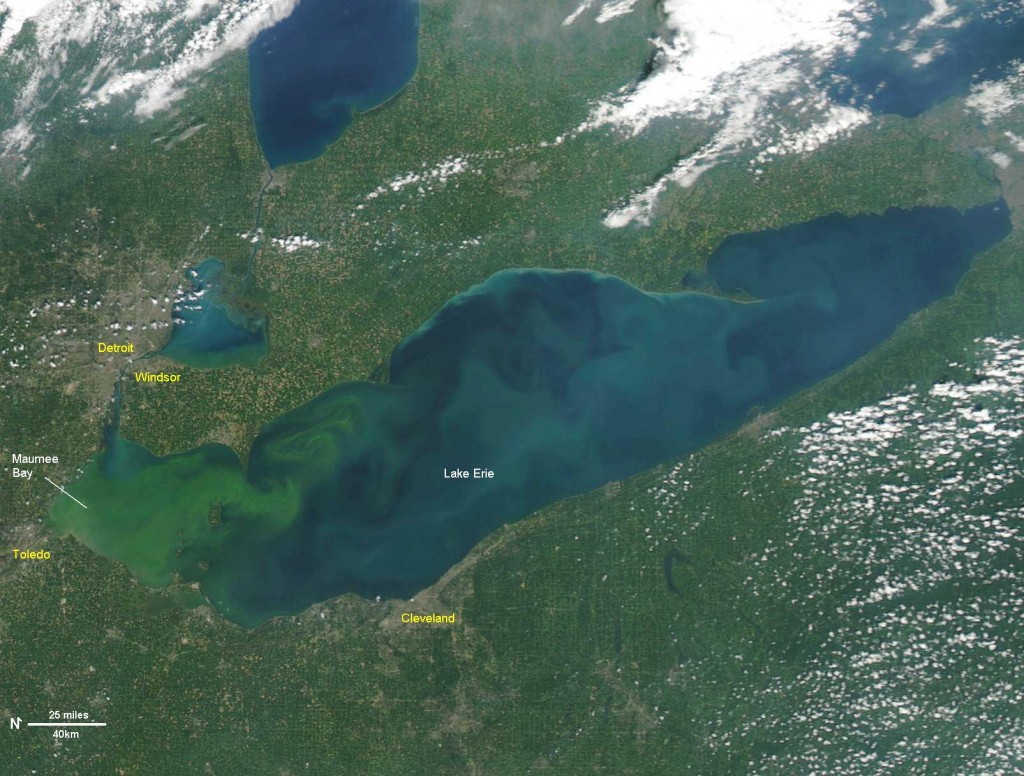12 September 2011
Lake Erie Algae Bloom
Posted by John Freeland

This September 3, 2011 MODIS image of Lake Erie reveals a bright green algae plume concentrated in the western basin. The western basin of the lake is the shallowest part and receives discharge from the Maumee River, the largest river watershed in the Great Lakes with 6,354 square miles (16,460 square km) of land drainage.
Land use in the watershed is about 85 percent agricultural and growers typically use a corn-soybean-wheat rotation.
Researchers at the University of Toledo report that microcystis is at record levels in the western basin. Tom Henry at Great Lakes Watch writes:
Microcystis is the most prevalent form of toxic algae, often referred to as harmful algal blooms. It has the same toxin, microcystin, that killed 75 people inside a Brazilian hospital in the mid 1990s, prompting a team of experts from the U.S. Centers for Disease Control and Prevention to investigate. Although microcystis-related problems are rare in the Great Lakes region, accidental ingestion of it – even through inhalation or skin contact – can, at a minimum, leave you feeling light-headed, dizzy, and sick. I know. I experienced that while collecting samples for my employer, The (Toledo) Blade, a year ago this month. Dogs that lap up microcystis-infested water along a shoreline can die from it. Humans can too if they get enough in their system, although they are more likely to experience nausea, vomiting, and severe stomach cramps.
Bottom line: It’s poisonous. It’s not to be messed with.
The algae problem comes down to too much phosphorus from agriculture and urban combined sewer overflows. Until society demands stronger regulations for farm runoff and upgrades urban stormwater infrastructure, the algae trouble will likely continue to get worse.


 John Freeland earned a PhD in Soil Science (Pedology) at North Dakota State University and is a consultant working in the private sector. He has published soils research and taught at the high school and college levels. John is interested in wetlands, soil genesis, science communication, the intersection of art and science, and soil-water-landscape processes. John lives near the Ohio-Michigan border and plays bass in multiple music projects.
John Freeland earned a PhD in Soil Science (Pedology) at North Dakota State University and is a consultant working in the private sector. He has published soils research and taught at the high school and college levels. John is interested in wetlands, soil genesis, science communication, the intersection of art and science, and soil-water-landscape processes. John lives near the Ohio-Michigan border and plays bass in multiple music projects.
[…] Sept 3, 2011 MODIS image of Lake Erie shows the bright green algae plume concentrated in the western basin. Source: AGU […]
Actually, paralytic shellfish poisoning is caused by shellfish absorbing the toxins from this cyanobacteria (and a few other species).
Classic signs of PSP is flaccid paralysis, preceded by one striking and ominous symptom: When the patient is presented with ice, the patient experiences a burning sensation when the ice contacts the tongue.
One investigational treatment is mannitol, which in several documented cases, reduced hospitalization from three months to three days. The down side of that treatment is, dual large bore IV fluids to replace the massive volume of fluid excreted by the kidneys.
Now, for prevention, one has to consider the sparse current choices.
Not use phosphorus laden fertilizers, which would reduce our crop productivity and yield.
Sequester the runoff in some way, as of yet undefined.
Treat the runoff in some way, removing the phosphorous compounds, in some as of yet undefined way.
The former notion is absurd, we NEED that produce to survive.
Sequestration of vast amounts of water isn’t an option, it provides a NEW growth medium for that cyanobacteria.
Treatment might be possible. THAT is something for chemical engineers to provide a workable and economic design.
Unless, of course, someone else has a GOOD AND WORKABLE idea that isn’t suggested above. Or even a wild idea that suggests a good idea. 🙂
Because, two things are double plus ungood:
1: Starvation.
2: Cyanobacteria blooming.
There are a number of strains of algae that are being considered for bio fuel production on a massive scale. Could some of these strains be used to both treat the waste and produce bio fuel?
[…] Source: AGU Blogosphere, https://blogs.agu.org/terracentral/2011/09/12/lake-erie-algae-bloom/ […]